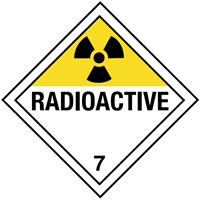
 Print
Print
Chemical Datasheet
THORIUM OXIDE, [RADIOACTIVE MATERIAL, LOW SPECIFIC ACTIVITY] |

|
Chemical Identifiers
| CAS Number |
UN/NA Number |
DOT Hazard Label |
USCG CHRIS Code |
|
|
|
|
none
|
| NIOSH Pocket Guide |
International Chem Safety Card |
|
none
|
none
|
NFPA 704
data unavailable
General Description
White powder. Density 9.7 g / cm3. Not soluble in water. Used in high-temperature ceramics, gas mantles, nuclear fuel, flame spraying, crucibles, non-silicia optical glass, catalysis, filaments in incandescent lamps, cathodes in electron tubes and arc-melting electrodes.
Hazards
Reactivity Alerts
Air & Water Reactions
Insoluble in water.
Fire Hazard
Excerpt from ERG Guide 161 [Radioactive Materials (Low Level Radiation)]:
Some of these materials may burn, but most do not ignite readily. Many have cardboard outer packaging; content (physically large or small) can be of many different physical forms. Radioactivity does not change flammability or other properties of materials. (ERG, 2024)
Health Hazard
Excerpt from ERG Guide 161 [Radioactive Materials (Low Level Radiation)]:
Radiation presents minimal risk to transport workers, emergency response personnel and the public during transportation accidents. Packaging durability increases as potential hazard of radioactive content increases. Very low levels of contained radioactive materials and low radiation levels outside packages result in low risks to people. Damaged packages may release measurable amounts of radioactive material, but the resulting risks are expected to be low. Some radioactive materials cannot be detected by commonly available instruments. Packages do not have RADIOACTIVE I, II, or III labels. Some may have EMPTY labels or may have the word "Radioactive" in the package marking. (ERG, 2024)
Reactivity Profile
Has only weak oxidizing powers. Redox reactions can however still occur. Not water-reactive. Soluble in sulfuric acid.
Belongs to the Following Reactive Group(s)
- Non-Redox-Active Inorganic Compounds
Potentially Incompatible Absorbents
No information available.
Response Recommendations
Isolation and Evacuation
Excerpt from ERG Guide 161 [Radioactive Materials (Low Level Radiation)]:
IMMEDIATE PRECAUTIONARY MEASURE: Isolate spill or leak area for at least 25 meters (75 feet) in all directions.
LARGE SPILL: Consider initial downwind evacuation for at least 100 meters (330 feet).
FIRE: When a large quantity of this material is involved in a major fire, consider an initial evacuation distance of 300 meters (1000 feet) in all directions. (ERG, 2024)
Firefighting
Excerpt from ERG Guide 161 [Radioactive Materials (Low Level Radiation)]:
Presence of radioactive material will not influence the fire control processes and should not influence selection of techniques. If it can be done safely, move undamaged containers away from the area around the fire. Do not move damaged packages; move undamaged packages out of fire zone.
SMALL FIRE: Dry chemical, CO2, water spray or regular foam.
LARGE FIRE: Water spray, fog (flooding amounts). (ERG, 2024)
Non-Fire Response
Excerpt from ERG Guide 161 [Radioactive Materials (Low Level Radiation)]:
Do not touch damaged packages or spilled material. Cover liquid spill with sand, earth or other non-combustible absorbent material. Cover powder spill with plastic sheet or tarp to minimize spreading. (ERG, 2024)
Protective Clothing
Excerpt from ERG Guide 161 [Radioactive Materials (Low Level Radiation)]:
Positive pressure self-contained breathing apparatus (SCBA) and structural firefighters' protective clothing will provide adequate protection. (ERG, 2024)
DuPont Tychem® Suit Fabrics
No information available.
First Aid
Excerpt from ERG Guide 161 [Radioactive Materials (Low Level Radiation)]:
Refer to the "General First Aid" section. Specific First Aid: Medical problems take priority over radiological concerns. Use first aid treatment according to the nature of the injury. Do not delay care and transport of a seriously injured person. Injured persons contaminated by contact with released material are not a serious hazard to health care personnel, equipment or facilities. (ERG, 2024)
Physical Properties
Flash Point: data unavailable
Lower Explosive Limit (LEL): data unavailable
Upper Explosive Limit (UEL): data unavailable
Autoignition Temperature: data unavailable
Melting Point: data unavailable
Vapor Pressure: data unavailable
Vapor Density (Relative to Air): data unavailable
Specific Gravity: data unavailable
Boiling Point: data unavailable
Molecular Weight: data unavailable
Water Solubility: data unavailable
Ionization Energy/Potential: data unavailable
IDLH: data unavailable
AEGLs (Acute Exposure Guideline Levels)
No AEGL information available.
ERPGs (Emergency Response Planning Guidelines)
No ERPG information available.
PACs (Protective Action Criteria)
| Chemical |
PAC-1 |
PAC-2 |
PAC-3 |
| Thorium oxide; (Thorium dioxide) (1314-20-1)
|
30 mg/m3 |
330 mg/m3 |
2000 mg/m3 |
(DOE, 2024)
Regulatory Information
EPA Consolidated List of Lists
| Regulatory Name |
CAS Number/
313 Category Code |
EPCRA 302
EHS TPQ |
EPCRA 304
EHS RQ |
CERCLA RQ |
EPCRA 313
TRI |
RCRA
Code |
CAA 112(r)
RMP TQ |
| Thorium dioxide |
1314-20-1 |
|
|
|
313 |
|
|
(EPA List of Lists, 2024)
CISA Chemical Facility Anti-Terrorism Standards (CFATS)
No regulatory information available.
OSHA Process Safety Management (PSM) Standard List
No regulatory information available.
Alternate Chemical Names
- THORIUM DIOXIDE
- THORIUM OXIDE, [RADIOACTIVE MATERIAL, LOW SPECIFIC ACTIVITY]


 Print
Print
